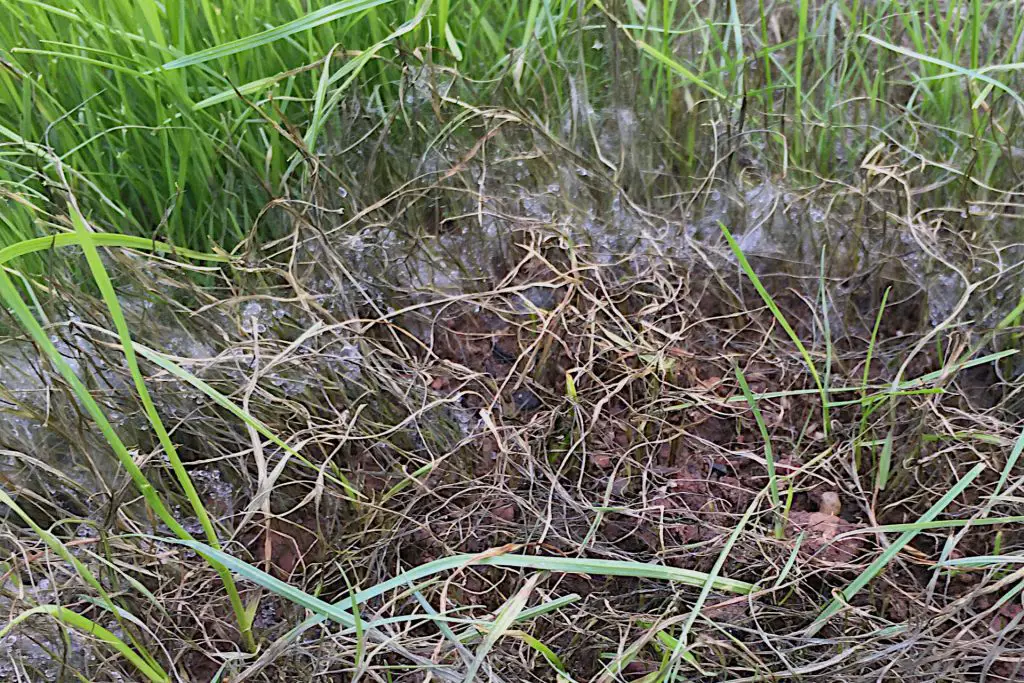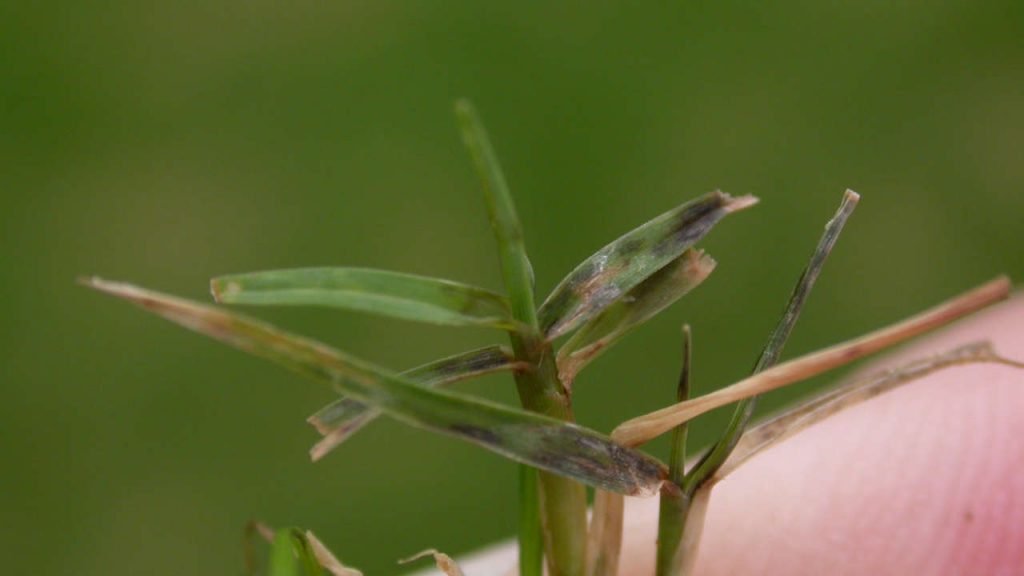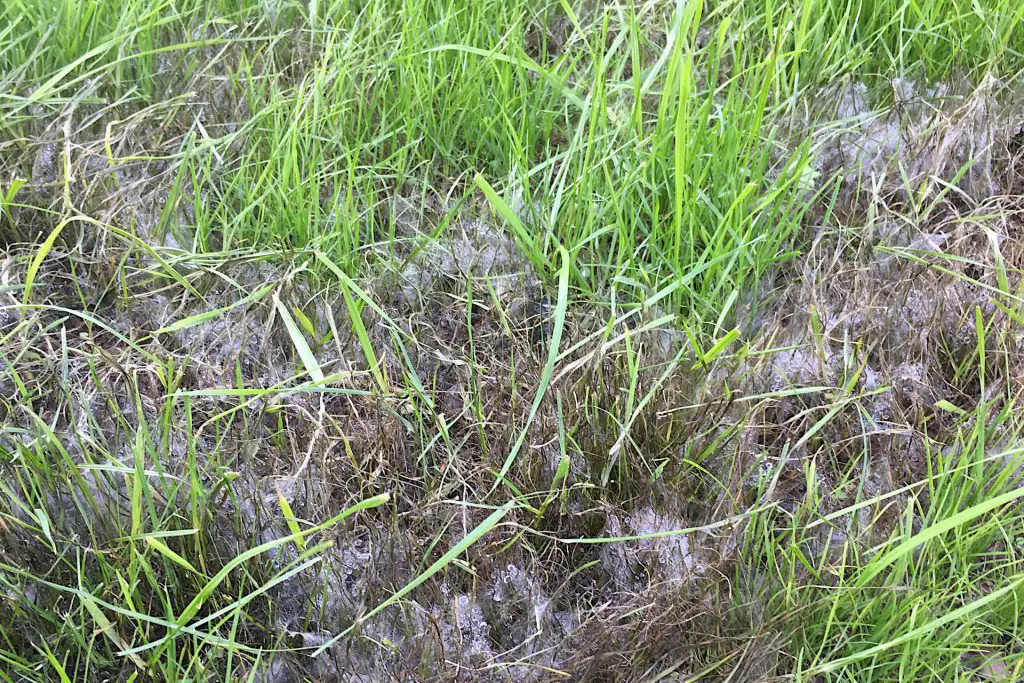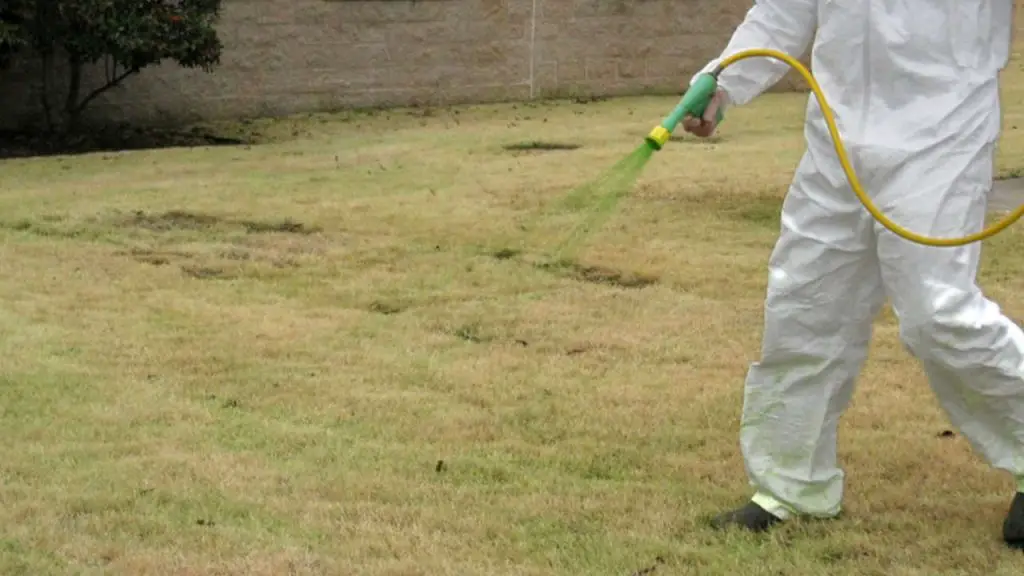Pythium Blight | How to Prevent and Treat Pythium Blight
Pythium blight (also referred to as grease spot, blight blade, or cottony blight) can provide significant challenges for homeowners looking to maintain a healthy lawn and even for those who practice commercial turfgrass management.
Below, we will provide a detailed examination of Pythium Blight, from its initial symptoms, which can range from wet patches to noticeable grass thinning, to its full-blown manifestation. Recognizing the disease’s signs and understanding its lifecycle is crucial for effective management.
We will delve into the intricacies of Pythium Blight, discussing its symptoms, causes, and the conditions that favor its proliferation. Moreover, we will present both cultural and chemical management strategies tailored for different turfgrass types, be it cool-season or warm-season varieties.
What is Pythium Blight

It is a grass fungal infection that can affect the majority of the most common cool-season turfgrasses. There are several species of the disease and it tends to be most prevalent during hot, humid weather. Turfgrass is particularly susceptible when conditions combine high temperatures (between 80°F to 90°F), wet soil, and minimal air movement over the turf.
The disease is destructive and can spread quickly, killing large areas of already-established turf or seedings in a couple of days. Although a predominantly hot weather fungus, it can also take hold during cool wet weather periods from 55°F to 65°F.
Pythium root and crown rot occur when root and crown tissue is attacked. This disease can strike at any time, whether the weather is hot, warm, or cool. Generally, the disease thrives in wet, humid conditions.
Symptoms of Pythium Blight
During hot, humid weather, Pythium blight initially shows up as small, sunken, circular patches up to six inches in diameter and can spread into significantly bigger irregular areas, particularly during extended periods of humid, rainy, and/or cloudy weather at any time of year.
These symptoms are sometimes confused with Dollar Spot, or Snow Mold (microdochium patch) so it is important to have an accurate diagnosis. The grass blades in affected regions are tangled, orange or dark grey in color, and greasy to the touch. When the leaves are wet or the humidity is high, grey, cottony mycelium can be seen in the infected areas.
The disease spreads quickly often along with drainage flows or mowing directions and can be traced using the right equipment. When conditions are favorable for the development of Pythium blight, these infections can cause extensive damage to a grass blade very quickly.
When Does Pythium Blight Occur?
For Pythium blight disease to take hold three factors need to be present. Firstly the pathogen needs to arrive or to be already dormant in your lawn. Secondly, the proper host is needed which unfortunately is the most common turfgrasses Lastly the day/night temperatures are greater than 55°F.
Pythium Blight Disease Cycle

This pathogen can lie dormant as resistant spores over the winter and other periods when disease development is hampered by climatic conditions. The pathogen can also be transported from one location to another through wind, soil movement, the use of garden equipment such as mowers, human foot traffic or water. It also thrives in over-fertilized alkaline-rich soil where there are high levels of nitrogen and low levels of calcium.
Pythium fungi can also cause ‘seed decay’ in turfgrasses. The fungus may also invade grass roots and crowns. This results in much-reduced growth and turf thinning. This is called Pythium root and crown rot.
Grass areas that become infected become staging posts from which the fungus spreads. If the weather is hot and humid, this spread can be rapid. Many grass varieties are favored by the disease due to high nitrogen fertility. Alkaline soil and soil deficient in calcium are also conducive to the disease.
How to Get Rid of Pythium Blight

Once you have a Pythium blight infection it can be hard to get rid of unless you catch it early, otherwise, you may well require a fungicidal solution. However, as with many lawn fungus diseases prevention is the best solution and limits your risk of your lawn being infected. Prevention can be either cultural, chemical, or a combination of both.
Cultural Control (non-Chemical) Pythium Blight Treatment
Cultural practices can be used to foster an environment where Pythium species infection is limited. Irrigation is a critical cultural practice that must be monitored. Watering early in the day allows grass blades to dry, reducing the likelihood of the blades being wet overnight. Watering also has an effect on the relative humidity of turfgrass blade coverage (foliar canopy). This is the main reason why watering in the evening should be avoided, particularly on hot days.
Pythium blight management should also include making sure there is good surface and subsurface drainage when laying and establishing new turfgrass lawns and renovating existing lawn areas where water pools.
Other critical management practices include removing thatch to improve drainage, reducing drought and nutrient stresses on turf, and removing Pythium inoculum sources. Excess thatch should be removed from the top of the grass as it can trap moisture underneath. To remove thatch, scarifying and or vertical mowing can be used.
Fertilizing Program
A well-balanced turfgrass nutrition system is also required for Pythium blight control. Excessive fertilization, particularly nitrogen applications, during the hot months can worsen disease severity.
Pythium blight likes nitrogen-rich soil therefore nitrogen levels applied to turf should be carefully monitored with monthly applications being no more than around ½ a pound of nitrogen per 1,000 square feet when the weather is hot. When applying nitrogen-based fertilizer try to use slow-release products when Pythium blight is most likely to occur. It is also critical to avoid calcium deficiency and to keep soil neutral or slightly acidic.
Creating Good Airflow
Getting air to your lawn can make a big difference. By cutting back trees and shrubs that surround grass areas you will help to promote good airflow across the lawn, which can significantly aid in the drying of grass when it gets wet. Also, you can improve turfgrass root growth by aerating your lawn and grass areas and reducing soil compaction. Delay overseeding with cool-season turfgrass species until late summer or early fall, when nighttime temperatures have dropped to 18°C (65°F).
Finally, when mowing your lawn, avoid areas of wet grass when the temperature is in excess of 70°F. It is good practice to thoroughly clean lawnmowers and other equipment before using them on unaffected areas as these practices will help to limit Pythium blight’s spread.
Fungicides (Chemical Control) – Pythium Blight Treatment

Cultural management may not be sufficient and if your lawn has been infected with Pythium blight then lawn fungicides (chemical solution) might be necessary.
Fungicide for Pythium Blight
There are various fungicides for pythium blight on the market that can effectively control and eliminate Pythium blight infection the most effective ones contain the following active ingredients: fosetyl-Al, chloroneb, or metalaxyl-M. In addition, there are other commercial fungicides that can be applied but these can, in certain states or countries be restricted to professional use only.
It is worth noting that the overuse use of certain Pythium fungicides, particularly metalaxyl or Mefenoxam (Phenylamides) can result in the pathogen becoming resistant to them. It is advisable to rotate between various fungicides or use fungicides from different chemical groups over a period of time to stop resistance from occurring. You can also cycle between contact and systemic fungicides to prevent any resistance from developing.
Best Fungicides for Pythium Blight
| Fungicide | Application Rate | Frequency | Notes |
|---|---|---|---|
| Mefenoxam (Subdue Maxx®) | 0.25 to 0.5 lbs per 1000 sq ft | 7 to 14 days or 3 to 5 days in some circumstances | Proven effective against Pythium Blight. |
| Propamocarb (Banol®) | 0.25 to 0.5 lbs per 1000 sq ft | 7 to 14 days | Effective against Pythium Blight. |
| Cyazofamid (Segway®) | 0.125 to 0.25 lbs per 1000 sq ft | 7 to 14 days | Newer product, reported to be very effective. |
| Fluopicolide (Stellar®) | 0.125 to 0.25 lbs per 1000 sq ft | 7 to 14 days | Newer product, reported to be very effective. |
| Phosphonate Products (e.g., Fosetyl Al – Chipco Signature®) | 0.25 to 0.5 lbs per 1000 sq ft | 7 to 14 days or 3 to 5 days in some circumstances | Potentially effective when applied preventatively and under low to moderate disease pressure. |
Note:
- The exact application rate and frequency need to be determined based on the specific product label and local regulations.
- Always follow the manufacturer’s guidelines and local regulations when applying fungicides.
- It’s crucial to accurately identify Pythium Blight as the fungicides effective against it may not control other diseases.
Overseeding
When looking to overseed you can buy pretreated seed is available for turfgrass establishment or for overseeding dormant warm-season grasses.
Best Grass Species to Prevent Pythium Blight
Some grass species are better than others at preventing Pythium blight from occurring in the first place. Below we have listed some of the most common grass species and their resistance to the fungus.
Cool-Season Grass Species – Resistance to Pythium Blight
| Grass Species | Resistance Level to Pythium Blight | Notes |
|---|---|---|
| Kentucky Bluegrass | Moderate to High | Can still become infected but usually less severe damage. |
| Creeping Bentgrass | Moderate | Can be severely affected under conducive conditions. |
| Tall Fescue | High | Damage is usually less severe. |
| Perennial Ryegrass | Low to Moderate | Often susceptible, especially under humid conditions. |
Warm-Season Grass Species – Resistance to Pythium Blight
| Grass Species | Resistance Level to Pythium Blight | Notes |
|---|---|---|
| Bermuda Grass | Moderate | Can be affected, especially in humid conditions. |
| Zoysia Grass | Moderate to High | Generally more resistant but not immune. |
Note: The resistance levels and notes are generalized and actual resistance can depend on the specific cultivar of the grass species and local growing conditions. Always consult with a local turfgrass specialist or extension service for the most accurate recommendations for your area.
Case Studies

#1: Battling Persistent Pythium Blight
Introduction
A homeowner, let’s call them Alex, encountered a perplexing issue with their lush lawn, which, over weeks, transformed into a patchy, discolored battleground.
Problem Statement
Alex’s lawn, once a vibrant green, began showcasing alarming signs, with greasy patches and a notable thinning of grass, indicative of Pythium Blight.
Approach: How to Treat Pythium Blight
- Identification: Alex identified cottony, mycelium structures during the early morning dew, a classic symptom of Pythium Blight.
- Cultural Management: Implemented strategies like altering watering schedules to reduce leaf wetness and aerating the lawn to improve soil drainage.
- Chemical Control: Employed fungicides, ensuring to rotation between different FRAC groups to minimize resistance development.
Outcome
A gradual recovery of the lawn was observed, with reduced disease incidence and a slow return of the lush green aesthetic after consistent management practices.
Take Aways
- Early Detection: The importance of early detection was paramount to managing the spread effectively.
- Consistent Management: Consistent and varied management strategies were key to combating the persistent pathogen.
- Community Learning: Sharing and learning from community experiences provided new insights and strategies to try.
Note: This case study is derived from a real-life scenario.
#2 Addressing Pythium Blight in a Newly Established Pet Lawn
Introduction
This case study examines a scenario involving the development and subsequent challenge of establishing a pet-friendly lawn, which encountered complications due to Pythium Blight.
Problem Statement
The individual established a lawn by planting Sunday pet lawn grass seed in a 5’x15’ area, previously utilized as a planter. Despite initial successful germination within five days, the emergence of Pythium mycelium and resultant dead patches presented a significant issue, particularly following a period of high humidity after drought-like conditions.
Approach: How to Treat Pythium Blight
- Initial Planting: Ryegrass, known for its quick germination, was the primary component of the chosen seed.
- Watering Strategy: A manual watering approach was adopted during the drought period to ensure sufficient moisture.
- Disease Identification: The appearance of Pythium mycelium was identified as a potential threat to the lawn’s health.
Outcome
The lawn experienced partial damage due to Pythium Blight, leading to the presence of dead patches and prompting a reassessment of the project’s viability.
Insights
- Artificial Grass Concerns: The potential odor retention of artificial grass was highlighted.
- Seed Selection: The recommendation was made to utilize Kentucky Bluegrass (KBG) due to its self-repair and spreading capabilities, suitable for climate zone 5b.
- Disease-Resistant Varieties: The importance of selecting seeds with multiple, disease-resistant cultivars was emphasized, with specific product suggestions provided.
- Overseeding and Maintenance: Guidance was offered regarding overseeding in the fall, implementing specific mowing and watering practices, and using Tenacity for weed control during seeding.
Take Aways
- Importance of Grass Type: Selecting a grass type that aligns with climate conditions and offers disease resistance is crucial.
- Valuable Community Input: Community forums can be a source of practical advice and alternative solutions.
- Evaluating Alternatives: Assessing the practicality and long-term sustainability of natural versus artificial options is essential.
Note: This case study is derived from a real-life scenario and hopefully structured and informative overview for individuals facing similar lawn management challenges.
Final Thoughts: Dealing with Pythium Blight
Having a proper lawn care program should include a program for dealing with the periods where your lawn is at the highest risk from Pythium blight and adjust your fungicide program to accommodate. In addition, having a program for monitoring for possible outbreaks of Pythium blight can help drastically reduce the damage that could subsequently be caused.
One aspect should also include monitoring air temperature and relative humidity (RH). The time of high disease risk from a Pythium blight infection is when nighttime temperature and relative humidity, when added together, are 150 or above. For example, if the nighttime temperature was around 70°F and humidity was greater than 90% then the total of 160 should be a warning of possible disease occurrence.
